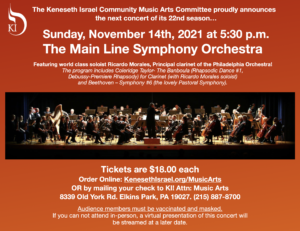Event details
- Sunday | November 14, 2021
- 5:30 pm
- 8339 Old York Road Elkins Park, PA 19027
- (215) 887-8700
 The Keneseth Israel Community Music Arts Committee proudly announces the next concert of its 22nd season…
The Keneseth Israel Community Music Arts Committee proudly announces the next concert of its 22nd season…Audience members must be vaccinated and masked. If you can not attend in-person, a virtual presentation of this concert will be streamed at a later date.
Ricardo Morales, guest soloist, is one of the most sought after clarinetists of today. He joined The Philadelphia Orchestra as principal clarinet in 2003 and made his solo debut with the Orchestra in 2004. Mr. Morales is the Leslie Miller and Richard Worley Principle clarinet chair. He previously served as principal clarinet of the Metropolitan Opera Orchestra. During his tenure with that ensemble, he soloed at Carnegie Hall and on two European tours. He has also been a featured soloist with the Chicago Symphony, the Cincinnati Symphony, the Indianapolis Symphony, the Seoul Philharmonic, the Columbus Symphony, the Memphis Symphony, and the Flemish Radio Symphony. In addition, he was a featured soloist with the U.S. Marine Band, “The President’s Own,” with which he recorded Jonathan Leshnoff’s Clarinet Concerto, a piece commissioned for him by The Philadelphia Orchestra. Mr. Morales has been asked to perform as principal clarinet with the New York Philharmonic, the Chicago Symphony, and, at the invitation of Sir Simon Rattle, the Berlin Philharmonic.
An active chamber musician, Mr. Morales has performed at the Santa Fe Chamber Music Festival, the Philadelphia Chamber Music Society, the Seattle Chamber Music Summer Festival, and with the Chamber Music Society of Lincoln Center.
Mr. Morales’s debut solo recording, French Portraits, is available on the Boston Records label. His recent recordings include performances with the Kalichstein-Laredo-Robinson Trio; the Pacifica Quartet, which was nominated for a Latin Grammy Award; and of the Mozart Concerto with the Mito Chamber Orchestra (Japan).
A native of San Juan, Puerto Rico, Mr. Morales began his studies at the Escuela Libre de Musica along with his five siblings, who are all distinguished musicians. He currently serves on the faculty of Temple University and is visiting professor at the Shanghai Conservatory of Music.
Don S. Liuzzi, Conductor of Main Line Symphony Orchestra, is the Dwight V. Dowley Principal Timpani Chair of the Philadelphia Orchestra. Born and raised in Weymouth, Massachusetts, he completed high school in Philadelphia at the Franklin Learning Center. He earned his Bachelor of Music degree from the University of Michigan and his Master of Music degree from Temple University. His primary teachers were Alan Abel, Charles Owen, and John Soroka.
Before joining The Philadelphia Orchestra in 1989, Mr. Liuzzi was a member of the Pittsburgh Symphony percussion section from 1982 to 1989. While in Pittsburgh he taught percussion and conducted the percussion ensemble at Duquesne University, was assistant conductor of the Three Rivers Young Peoples Orchestra, and appeared on PBS’ nationally syndicated Mr. Roger’s Neighborhood, performing marimba and percussion solos.
Beyond his over 60 commercial recordings as principal timpani of The Philadelphia Orchestra, Mr. Liuzzi can be heard on several Decca releases with Seiji Ozawa’s Saito Kinen Festival Orchestra, with which he has been a guest timpanist for five seasons. As a former percussionist with the Network for New Music, and also for area composers, he has recorded contemporary chamber works for the CRI, Crystal, and Albany labels. His percussion solo and chamber CD release from 2012, Movement in Time (Equilibrium), is volume I of the Philadelphia Percussion Project. This first volume features music by Maurice Wright, Maurice Rissman, and William Kraft. Volume II, Zones, was released in May 2015 and is a Philadelphia Orchestra percussion group (POPG) recording featuring Jennifer Higdon’s Zones, as well as six other world premiere recordings including his own composition, Seoul Spirit. A participating musician in the documentary film Music from the Inside Out (2005), Mr. Liuzzi also served as the film’s coordinating producer and was integral in helping develop the accompanying middle school teaching curriculum published by Alfred Books. The feature length film by Anker Productions, which features The Philadelphia Orchestra, was re-released digitally on iTunes in June 2013 and is also available on Netflix. Mr. Liuzzi’s other electronic media activity (under his company name of Beat the Drum Entertainment, Inc.) has included two other CD projects with the DePue Brothers Band: performing drums and singing, and executive producing Weapons of Grass Construction and their latest album, When It’s Christmas Time, released in December 2013.
Mr. Liuzzi has given master classes at most major music schools throughout the United States and in Canada, Mexico, Argentina, Spain, Korea, Japan, and China. He has been a percussion and timpani coach at the National Orchestral Institute, the New World Symphony, the Pacific Music Festival, the Canton International Summer Music Academy, the Lindenbaum Music Festival (in Korea), the Youth Orchestra of the Americas, and the National Youth Orchestra USA run by Carnegie Hall. He joined the faculty of the Curtis Institute of Music in January 1994. He has also held faculty positions at Rowan University and guest faculty status at Indiana University of Pennsylvania and the Manhattan School of Music. Mr. Liuzzi just completed 10 years as music director of the Philadelphia All City High School Orchestra, and is founding conductor of the Curtis Institute’s 20-21 New Music Ensemble.
Mr. Liuzzi’s early orchestral experience included the Flint Symphony, the Michigan Opera Theater Orchestra, and the Colorado Philharmonic. He has also played in the Spoleto Festival Orchestra for three seasons and was a Tanglewood Fellow in 1980. In July 1996 he made his solo debut with The Philadelphia Orchestra at the Mann Center for the Performing Arts, and his subscription solo debut in January 1998. Having consulted with Yamaha for over 15 years on the development of professional timpani, he is now a Yamaha performing artist, with a highly-regarded YouTube solo appearance and interview through his Yamaha affiliation. He is married with two adult daughters
Beethoven’s Symphony #6
Beethoven’s #6, depicts, in a classical format, a day’s outing to the countryside. Each movement musically describes a scene or event of that day. Beethoven had already “broken the mold” many times in his career, and here he pushes the envelope further by impressing a story onto a symphony, adding a fifth movement to the usual four, the last three played without pause. It might not be the first program symphony ever written, but it is surely one of the most important. As is well known, Walt Disney was so taken with the evocative content of this symphony that in 1940 he made the imagery concrete in his landmark film, “Fantasia”.
The first movement, “Awakening of cheerful feelings upon arrival in the countryside”, has all of the “requirements” of a symphonic opener: main and secondary themes, modulation, development, recapitulation. But in contrast to its intense, fiery predecessor, the 5th Symphony, the focus here is on its calm, static aura, that slows time and encourages us to lie back, enjoy, and absorb the expanse of nature all around.
It is impossible to miss the instrumental depiction of a quietly rippling stream in the accompaniment of the second movement, “Scene by the brook”, or the bird calls at the end. The colorful portrayal in the next movement of the “Spirited gathering of the village folk” strings together several earthy dance tunes, some stomping and spirited, others light and weightless. The onset of “Rain and storm” interrupts the party with a fearsome, ferocious cataclysm, the wind, rain, and lightning almost palpable. After the storm finally blows itself out, a “Shepherd’s song. Cheerful and thankful feelings after the storm” ends the symphony.
This piece received its first performance in 1808, in what must have been a truly astonishing concert. It lasted 4 hours, and premiered in addition the Symphony #5, the Piano Concerto #4, and more. Over the two centuries since that day, composers have taken up Beethoven’s challenge, writing further programmatic symphonies, incidental music, or the new genre of the tone poem. We owe a debt to Beethoven and this symphony whenever we hear Berlioz’ Symphonie Fantastique, Liszt’s “Mazeppa”, Grieg’s “Peer Gynt”, Smetana’s “The Moldau”, Richard Strauss’ “Til Eulenspiegel”, or countless other great programmatic works. Program Note by Don Greenfield
Claude Debussy (1862-1918) –
Premiere Rhapsodie pour Clarinette
Composition did not initially come easily to Claude Debussy. His talent at the piano was recognized early enough that he gained entrance to the prestigious Conservatoire in Paris at age ten (1872). For the next ten years, he became known more for skipping his classes, being forbidden to continue in the piano program, and frustrating his conservative composition teachers by rejecting their adherence to the rules established by the predominant Germanic composers of the early 19th Century. During the decade of the 1880s Debussy attempted five operas, all left in fragments. The genius of Debussy that we know from his small output of compositions for full symphony orchestra blossomed after he attended the 1889 Paris World Exposition; he was introduced to the sounds of Gamelan from Java, and the “exotic” colors, melodies and harmonies of Russian music performed in concerts conducted by composer Rimsky-Korsakov. In the decade after the 1889 Exposition, Debussy made his mark on the world with Prélude à l’après-midi d’un faune, the first two Nocturnes (Nuages and Fetes), and the opera Pelleas et Melisande. Two more pillars of the orchestral repertoire followed in the decade of the 1900s: La Mer, and Images for Orchestra. In 1909, composer Gabriel Fauré invited Debussy to sit on the governing council of the Conservatoire. It was in that capacity that Debussy composed Première rhapsodie as an examination piece for the Concours the following year. It is unclear whether Debussy planned to compose a subsequent Rhapsody for an accompanied solo instrument. The so-called “Second Rhapsody” for Alto Saxophone and Orchestra was drafted by Debussy in 1903 and set aside, and it was completed and orchestrated by Jean Roger-Ducasse after Debussy’s death. The year 1909, which had brought such honor to the composer, also marked the end of his most creative period. Debussy was diagnosed with cancer, from which he suffered painfully for his remaining years. Nonetheless, he published an orchestration of Première rhapsodie in 1911. This bright, compact jewel of the repertoire for Clarinet and Orchestra is significant in several ways. It is the only composition we have for solo instrument with full orchestra which is completely Debussy. It is the culmination of his most creative period of the 20 years, after Debussy found his voice as a composer. Debussy did compose a few orchestral pieces during his remaining years and, except for the short ballet Jeux, required the help of composers Charles Koechlin, Andre Caplet, and Roger-Ducasse to bring them to completion. Program Note by Steward Young
